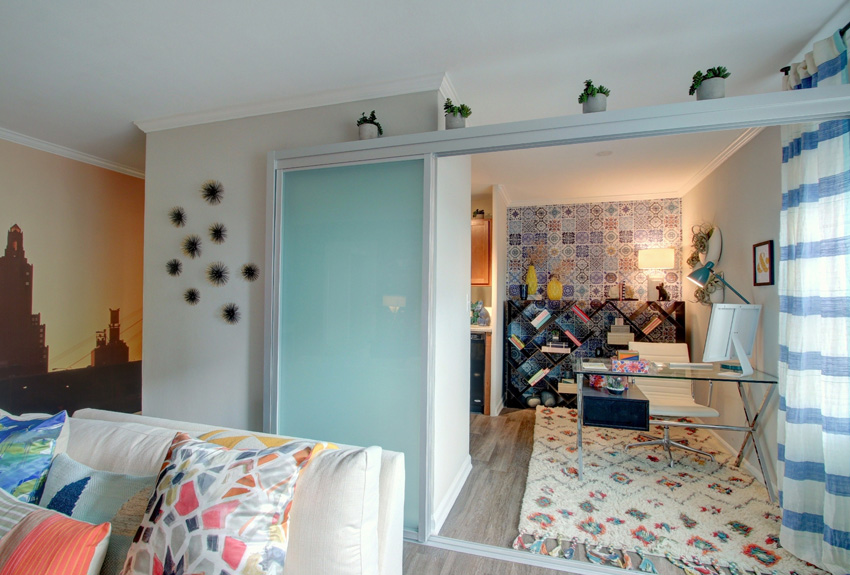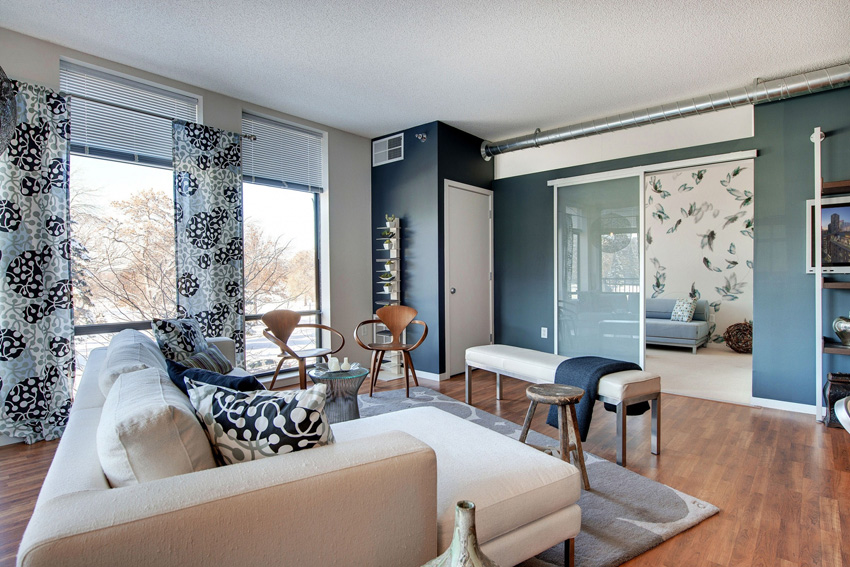Maximizing Value with Interior Glass Door Solutions
Studios and Lofts
While corporate workplaces are embracing the advantages of interior glass partitions, they are also trending in multiunit properties, particularly studios and lofts.

This wall slide door, which takes up practically no floor space, divides up the open space at this Village Green apartment.
“Breakout spaces are an important emerging trend in multifamily properties and can be a factor in leasing or purchasing decisions,” Rodriguez says.
While a noted percentage people want to live in urban areas, many cannot afford the cost of downtown rent. As a result, Aeron Hodges, associate, Stantec, Boston, relates that an interest in co-living has taken hold. By dividing a space into two separate bedrooms, two parties can then share the cost of the lease. Or the landlord can break out the space into two separate rentable units.
And like office conversions, these residential configurations can also be done in a time-efficient, nondisruptive manner.
Beyond the economics, studio and loft owners are turning to these solutions to make their apartments more functional. “The ability to delineate between public and private space is a major benefit of glass doors and partitions,” Rodriguez says.

Glass room dividers carve out a private space.
For example, CetraRuddy recently designed a residential conversion of a former hotel in Midtown Manhattan. Because many of the studio apartments were very compact, the architect enclosed the bedroom areas with a textured, back-painted glass wall, which creates the illusion of a much larger space while clearly delineating public and private uses.
For another project on Manhattan’s Upper West Side, sliding glass doors with a thin metal frame and shimmering metal mesh interlayer were specified to separate the living room from the kitchen.
“In multifamily settings, many people are looking for rooms that can grow with their personal life: from being an office or a music room to a nursery and second bedroom,” Rodriguez says. “Sliding glass doors offer flexibility between public and private space and allow for a range of uses in what would otherwise be unused space in a unit’s core.”

These frosted glass enclosures offer a combination of transparency and visual privacy.
Overall, loft and studio units are challenging to compartmentalize due to their size. While separate spaces can be formed by furniture or other room divider systems, Semple points out that glass is advantageous for its transparency and acoustics. “Most importantly, glass can define a space without interfering with important views,” he says.
“There is significant value in the possibility of adding what is effectively a whole new room that does not need windows in order to have access to natural daylight and a feeling of openness,” agrees Rodriguez.
Many glass dividers do not need to extend to the ceiling and therefore enable heated or conditioned air to flow through the space, keeping the apartment cooler in the summer and warmer in the winter, thereby reducing energy costs. Additionally, there is no need to reroute HVAC, which can be quite costly for landlords.
In many cases, there is interest in creating separation between the bedroom and the living areas. Or perhaps a resident wants to cordon off a proper office space as opposed to a desk and computer in the corner of the bedroom. In larger loft spaces, there may be interest in creating a guest bedroom.
In all these cases, the conversions can be done in an aesthetic way that does not compromise daylighting or cut off the flow of the space. Incidentally, sliding glass doors are also a clever way to conceal a side-by-side washer/dryer or a stackable unit.
“There has always been a need for open loft spaces to define areas and create nodes of privacy,” confirms Hoefer Wysocki’s Bennett. “This trend toward flexibility allows lofts to be a consideration for people who may want the best of both worlds.”
Designers and owners also have a variety of designs options from which to choose based upon function and preference.
“The diversity of applications abounds in terms of finishes, inner layers, and combinations offering various properties such as transparency, acoustics, and temperature-control elements all within a seemingly simple material,” explains Blitz Design Director Justin Beadle, NCARB.
If a higher level of privacy is required, then a black, laminated opaque, or smoked milky glass might be a good choice. However, if maximum transparency is the goal, then clear or frosted glass will work best. In between the two extremes is semi-opaque glass, often called white laminated or milky glass.
ADA and LEED
In specifying glass door systems, designers must ensure that the entry mechanism and clearance meets Americans with Disabilities Act (ADA) requirements in commercial/public spaces. This applies to all places of public accommodation and commercial facilities, including office buildings, industrial facilities, stores and shops, restaurants and bars, sales or rental establishments, service establishments, theaters, places of lodging, recreation facilities, assembly areas, private museums, and places of education.
For residential properties, the Fair Housing Act mandates that all buildings with four or more units meet ADA accessibility requirements.
Consequently, accessible interior glass doors must provide at least 32 inches of clear width, measured between the face of the door itself and the opposite stop. The door hardware must not require more than 5 pounds of force to operate and must be operable with one hand and no tight grasping, pinching, or twisting of the wrist. Thresholds cannot be higher than a ½ inch at accessible doors, including sliding doors.
While LEED certification is not a requirement like ADA, sustainable products and designs are frequently prioritized in office and multiunit spaces.
“Consumers, specifically generation Z, want to know what they are purchasing has the best practices in place to support our planet, and they are willing to pay a premium,” James says.
In selected products and systems for these sustainable designs, Bennett stresses that these elements be carefully planned to ensure their marketability, sustainability, and long-term value.
Depending upon the interior glass walls and doors specified, these systems can contribute to LEED points in the following ways:
- Better waste management: Unlike conventional doors and walls, the framing methods and advanced materials in many glass systems support installation with no on-site debris.
- Indoor environmental quality: For designs that leave space between the top of the glass door and the ceiling, natural and ventilated air flow freely between the spaces, thus improving indoor air quality. Glass panes and aluminum frames replace wood and other moisture-absorbing materials, eliminating any concern for mold. Furthermore, finished glass systems do not need to be painted, further eliminating hazardous chemicals.
- Thermal comfort: Glass partitions allow heated or cooled air to flow through the space, keeping the rooms warmer in the winter and cooler in the summer.
- Enhanced lighting: Daylight passes through the glass walls and doors, enabling occupants to better benefit from well-being, satisfaction, and productivity associated with daylight.
Artificial lighting needs are decreased, thereby saving energy costs and delivering more natural spaces.
In all, glass walls and doors from certain manufacturers can contribute up to 14 LEED points.









